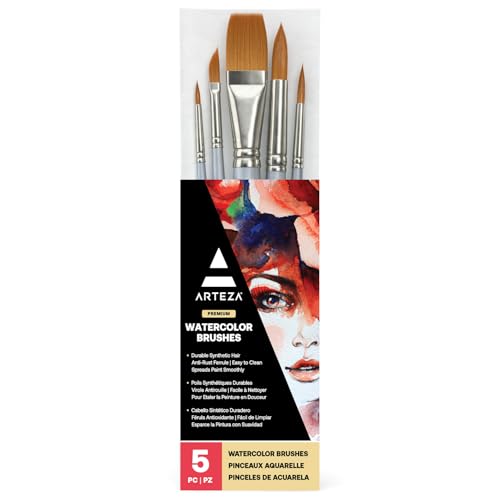
Watercolor Landscape Tutorial: Light Impression is a creative process that allows you to capture the beauty of nature in a loose and uncontrollable medium like watercolors.
In this tutorial, I will guide you through the essential steps, starting with light washes and gradually building up to darker tones and intricate details. This approach aims to help you understand the key principles of watercolor painting easily.
How to Paint landscape with Watercolor: Impression of light
Materials
I’m using several pigments:
- Jaune Brillant No.1,
- Jaune Brillant No.2
- Naples yellow
- Light Red
- Verditer Blue
- Davy’s Gray
- Lavender
- Cadmium yellow light
- Vermilion
- Shell Pink
And finally, the paper I’m using is Arches Watercolor Paper, Rough, 100 %cotton.
| Preview | Product | Rating | Price | |
|---|---|---|---|---|

|
Arches Watercolor Block 12x12-inch Natural White 100% Cotton Paper - 20 Sheets of Arches Watercolor... | No ratings yet | Buy on Amazon | |

|
Winsor & Newton Cotman Watercolor Paint Set, 20 Colors, 5ml (0.17-oz) Tubes | No ratings yet | $19.99 | Buy on Amazon |

|
ARTEZA Watercolor Paint Brushes, Set of 5, Assorted Shapes, Synthetic Soft-Bristle Brushes | No ratings yet |
$17.78 |
Buy on Amazon |
01. Preparing the Sketch

I start with a light pencil sketch to define the basic forms and shapes of the landscape as trees, grassy fields, and foliage.
Keep your lines soft and minimal, as watercolor is transparent and can show through the paint.
02. Wetting the Paper

In this step, I use a large flat brush to apply clean water to the paper, this’s known as the wet-on-wet technique.
Pre-wetting the paper makes it possible to ensure that the initial washes will blend naturally without hard edges.
Note that, avoid over-soaking the paper, you want to keep it damp enough for the paint to spread smoothly but not so wet that the color smudges uncontrollably.
03. Set the Base Wash

First, I start with the lightest colors. Apply a light layer of Jaune Brillant No.1 color to the entire paper, this base wash sets the tone for the entire painting.
Then, Use the Naples yellow on the part where I suggested the trees and field.
This initial wash should be light and even, creating a foundation for the following layers.
04. Building the Foliage of How to paint landscape with watercolor

In the next step, you may notice that I begin a combination of yellow and green hues to define the leaves and bushes.
By applying different shades of yellow (Naples Yellow, Cadmium Yellow light), green (Terre Verte), and a few soft oranges (Jaune Brillant No.2) to create a richness of color. However; at this time, the foliage is still quite vague and undefined.
05: Painting the Sky and Background

Use a tone of light yellow and light gray to suggest the clouds. The wet-on-wet technique is ideal for this part, as it allows the colors to blend smoothly and loosely.
Tip: First, use a light wash of Jaune Brillant No.2, while it is still wet, add a mix of gray ( lavender + Davi’s gray) for clouds. Keep the horizon lighter and less saturated, as distant skies are usually paler.
06. Adding First layer of Foreground

Next, define the foreground’s first elements using a combination of Shell Pink, Greenish yellow, Terre Verte, and Naples Yellow.,
07. Adding Depth and Shadows

The trees begin to take on a more distinct shape as darker shades of green are introduced. This step involves adding depth by focusing on where the light source hits the trees, and where shadows fall. As a result, the shadows in the trees and bushes give the painting a sense of dimension and a more realistic feel.
Mix a little blue or purple with your green to create cooler, darker tones for the shadows. Focus on the areas under the trees and on the side of the foliage that is furthest from the light source.
08. Enhancing the Background and Middle Ground

As you can see in the next step, the background and middle ground elements (such as distant trees) are now being filled in with darker shades of green (Terre Verte) and blue (Verditer Blue), helping to create perspective.
The further objects are in the landscape, the cooler and less detailed they become, this adds a layer of realism to the painting.
Use a thinner brush and lighter strokes for the distant trees and background elements. You want these parts to recede into the background, so avoid too much contrast or detail.
09. Suggesting some details of trunks and leaves

Besides, you may also add small highlights using a nearly dry brush technique to create texture on the tree trunks and leaves.
10. Detailing the Foreground

At this step, I went back into the foreground to add small details of the grass, which are now more defined with individual blades of grass painted in thin, fine strokes.

Then, use your fingers to gently rub away any masking fluid on the paper.
Final Touches : Watercolor Landscape Tutorial Light Impressions

In this last step, I apply the final touch. The foreground flowers are subtly indicated with small white and blue dots. The article How to paint landscape with watercolor is now complete with vibrant trees, and soft grass.
However, be careful not to overwork your painting at this stage. Add only the necessary details, and step back frequently to see how the overall composition looks.
